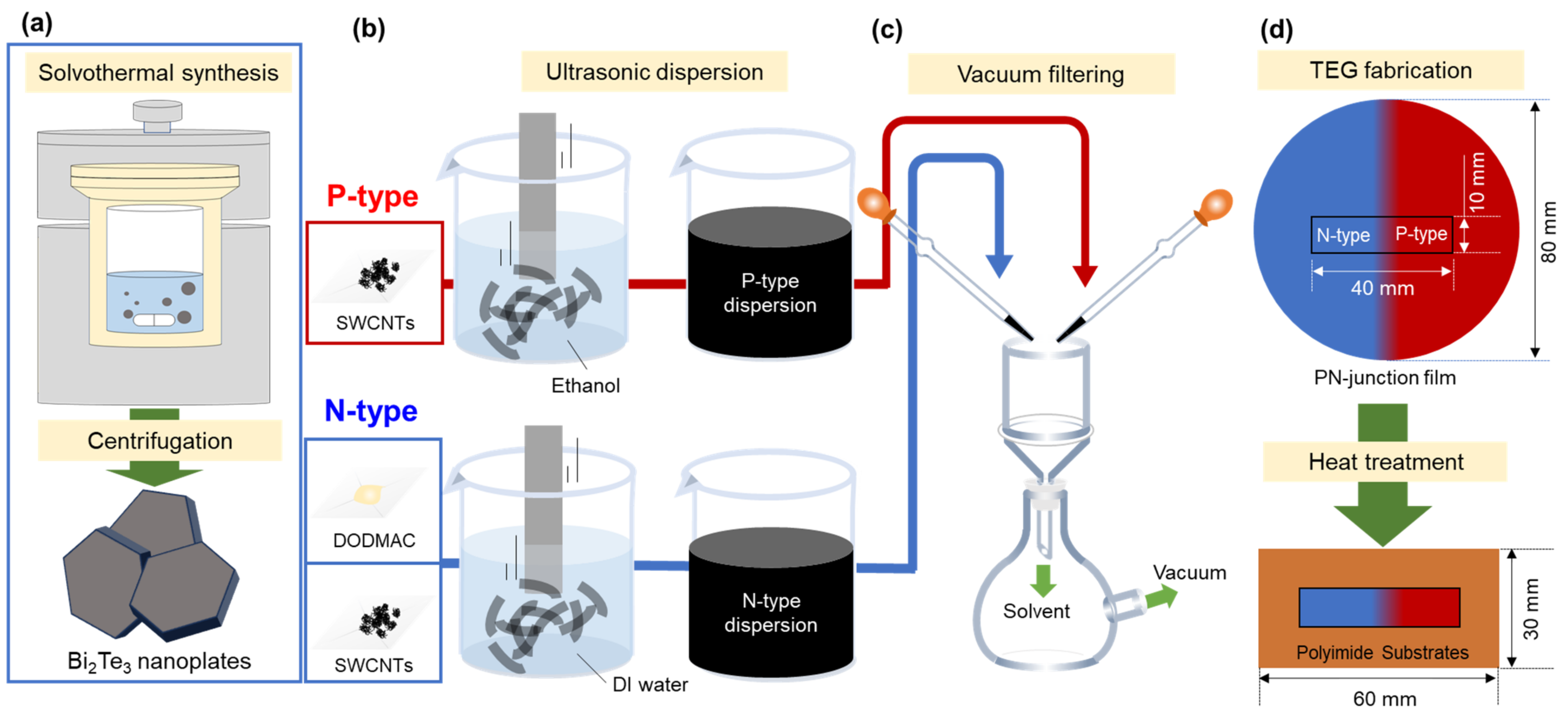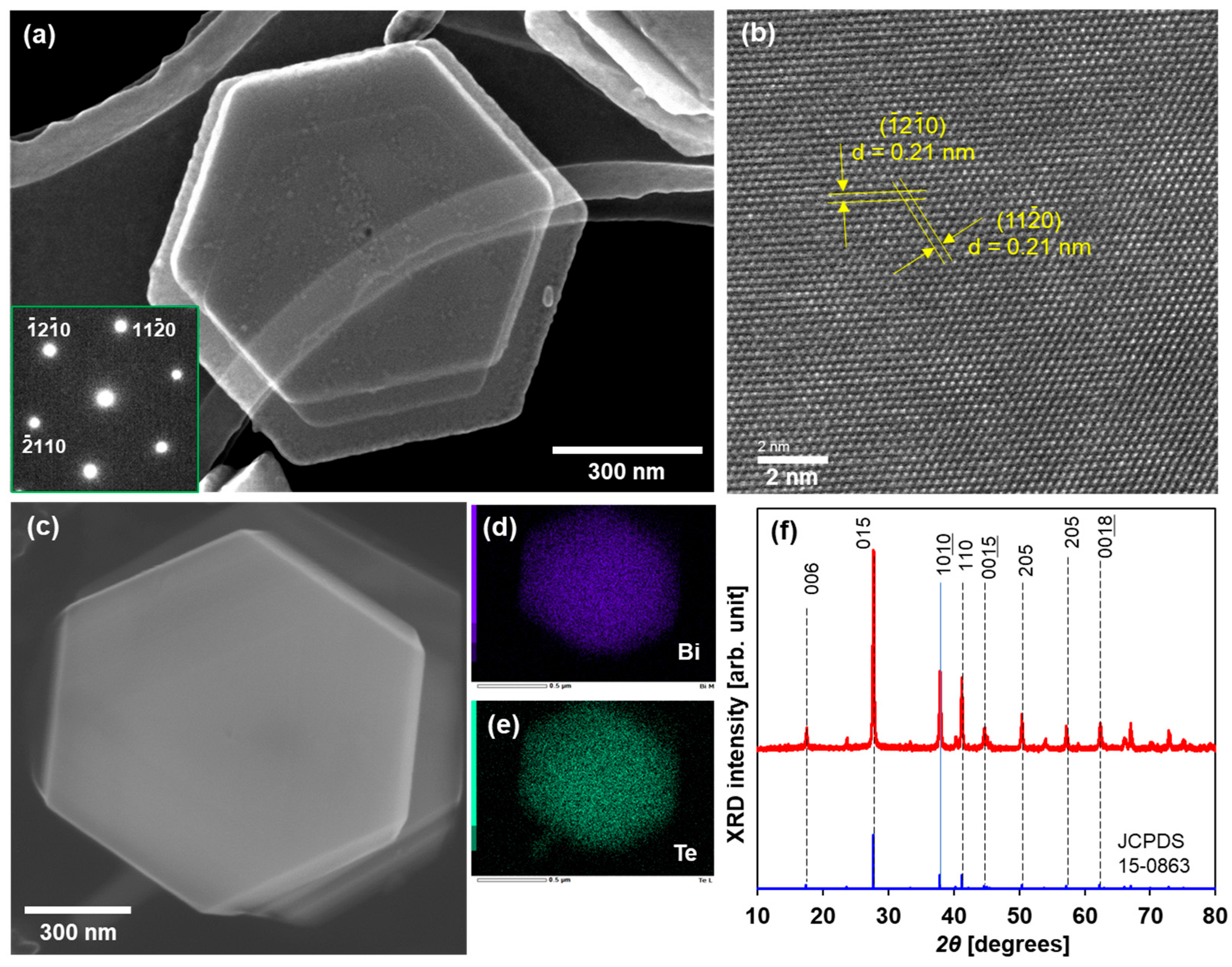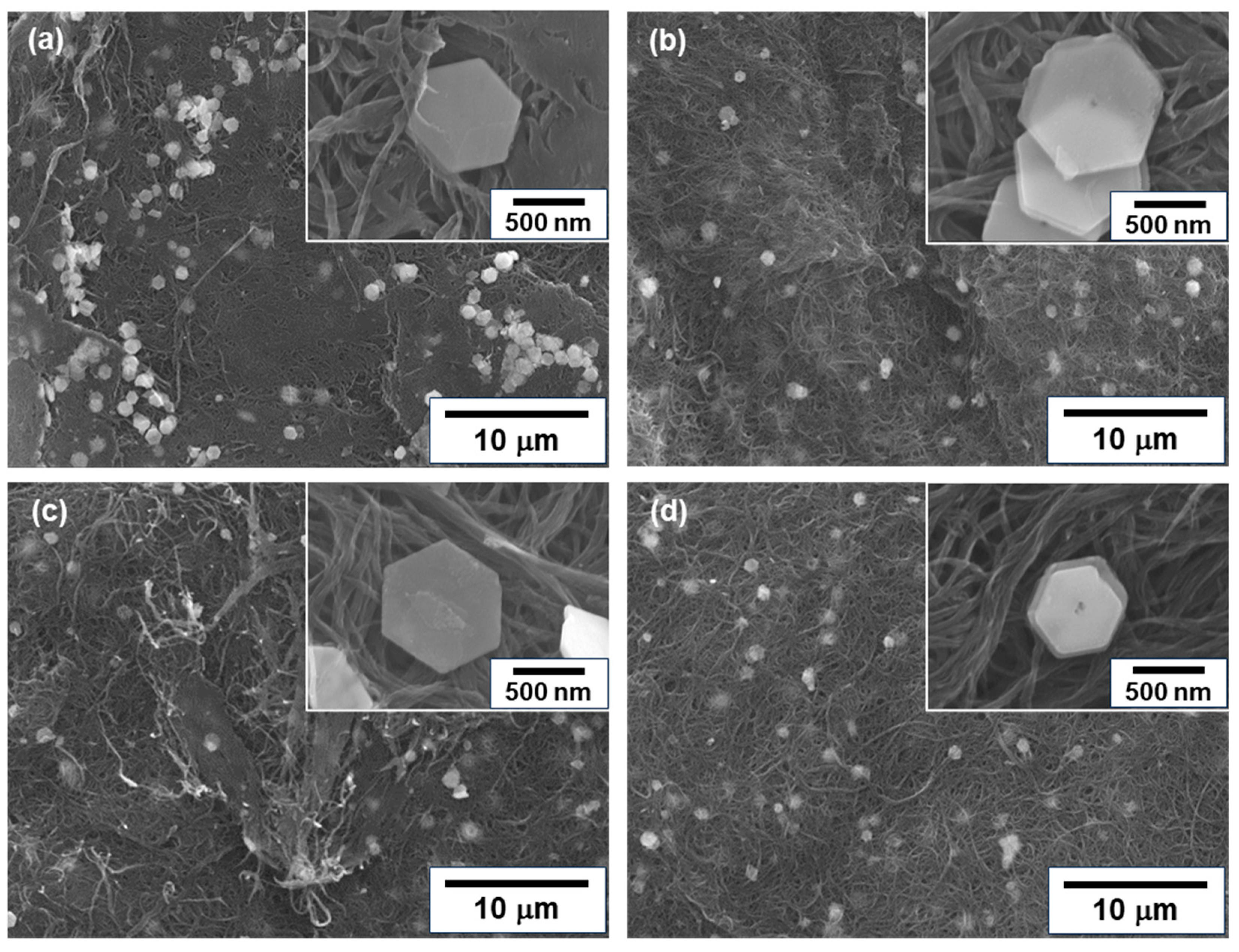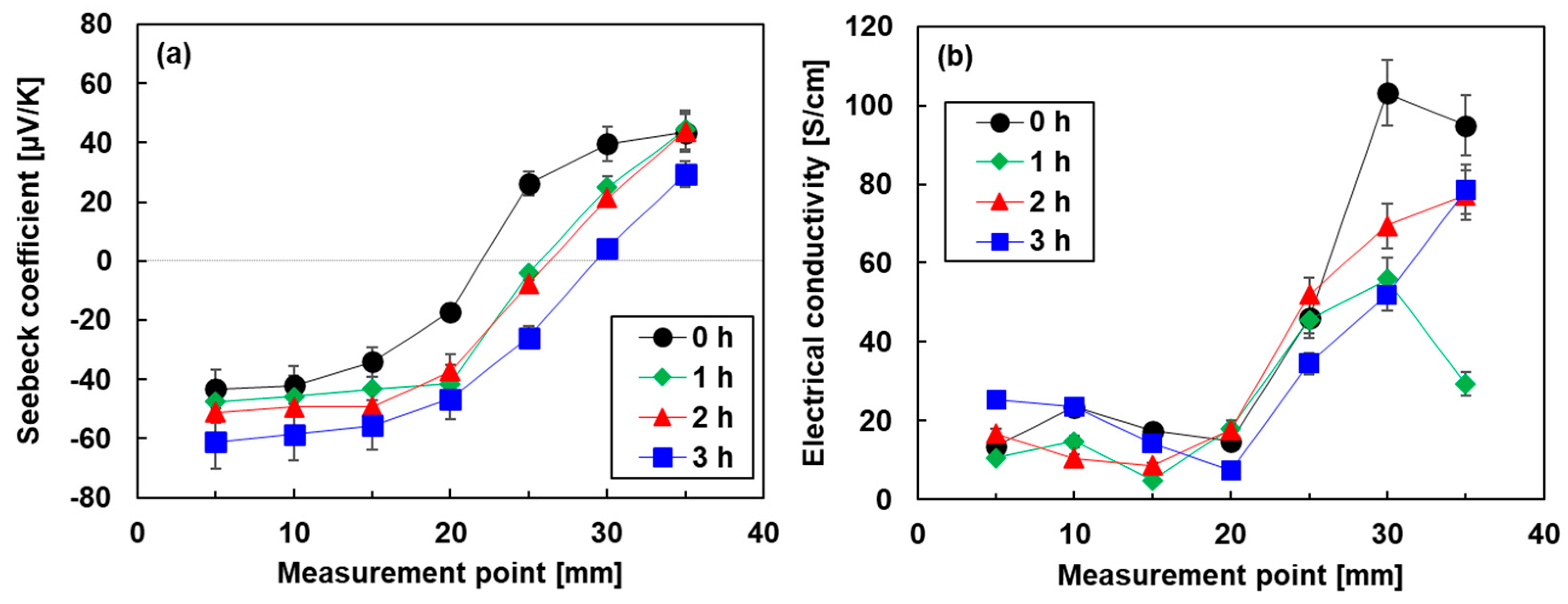N-Type Nanocomposite Films Combining SWCNTs, Bi2Te3 Nanoplates, and Cationic Surfactant for Pn-Junction Thermoelectric Generators with Self-Generated Temperature Gradient Under Uniform Sunlight Irradiation
Abstract
1. Introduction
2. Materials and Methods
3. Results and Discussion
3.1. Characteristics of Bi2Te3 Nanoplates
3.2. Characteristics of Nanocomposite Films
3.3. Performance of Pn-Junction Thermoelectric Generators
4. Conclusions
Supplementary Materials
Author Contributions
Funding
Data Availability Statement
Acknowledgments
Conflicts of Interest
References
- Toan, N.V.; Tuoi, T.T.K.; Ono, T. Thermoelectric generators for heat harvesting: From material synthesis to device fabrication. Energy Convers. Manag. 2020, 225, 113442. [Google Scholar] [CrossRef]
- Soleimani, Z.; Zoras, S.; Ceranic, B.; Cui, Y.; Shahzad, S. A comprehensive review on the output voltage/power of wearable thermoelectric generators concerning their geometry and thermoelectric materials. Nano Energy 2021, 89, 106325. [Google Scholar] [CrossRef]
- Zhang, O.; Deng, K.; Wilkens, L.; Reith, H.; Nielsch, K. Micro-thermoelectric devices. Nat. Electron. 2022, 5, 333–347. [Google Scholar] [CrossRef]
- Xu, X.; Gabor, N.N.; Alden, J.S.; Zande, A.M.; McEuen, P.L. Photo-thermoelectric effect at a graphene interface junction. Nano Lett. 2010, 10, 562–566. [Google Scholar] [CrossRef]
- Zhao, W.; Zhang, F.; Dai, X.; Jin, W.; Xiang, L.; Ding, J.; Wang, X.; Wan, Y.; Shen, H.; He, Z.; et al. Enhanced thermoelectric performance of n-type organic semiconductor via electric field modulated photo-thermoelectric effect. Adv. Mater. 2020, 32, 2000273. [Google Scholar] [CrossRef]
- He, M.; Lin, Y.J.; Chiu, C.M.; Yang, W.; Zhang, B.; Yun, D.; Xie, Y.; Lin, Z.H. A flexible photo-thermoelectric nanogenerator based on MoS2/PU photothermal layer for infrared light harvesting. Nano Energy 2018, 49, 588–595. [Google Scholar] [CrossRef]
- Komori, T.; Norimasa, O.; Yamamoto, H.; Hoshino, K.; Takada, Y.; Takashiri, M. Effect of Seebeck coefficient distribution across pn-junction in carbon nanotube films for photothermoelectric power generation by localized sunlight irradiation. Diam. Relat. Mater. 2023, 136, 109929. [Google Scholar] [CrossRef]
- St-Antoine, B.C.; Menard, D.; Martel, R. Photothermoelectric effects in single-walled carbon nanotube films: Reinterpreting scanning photocurrent experiments. Nano Res. 2012, 5, 73–81. [Google Scholar] [CrossRef]
- Li, K.; Kinoshita, Y.; Sakai, D.; Kawano, Y. Recent Progress in development of carbon-nanotube-based photo-thermoelectric sensors and their applications in ubiquitous non-destructive inspections. Micromachines 2023, 14, 61. [Google Scholar] [CrossRef]
- Fang, H.; Wu, P.; Wang, P.; Zheng, Z.; Tang, Y.; Ho, J.C.; Chen, G.; Wang, Y.; Shan, C.; Cheng, X.; et al. Global Photocurrent generation in phototransistors based on single-walled carbon nanotubes toward highly sensitive infrared detection. Adv. Opt. Mater. 2019, 7, 1900597. [Google Scholar] [CrossRef]
- Shastry, T.A.; Hersam, M.C. Carbon nanotubes in thin-film solar cells. Adv. Energy Mater. 2016, 7, 1601205. [Google Scholar] [CrossRef]
- Cai, B.; Su, Y.; Tao, Z.; Hu, J.; Zou, C.; Yang, Z.; Zhang, Y. Highly sensitive broadband single-walled carbon nanotube photodetectors enhanced by separated graphene nanosheets. Adv. Opt. Mater. 2018, 6, 1800791. [Google Scholar] [CrossRef]
- Bati, A.S.R.; Yu, L.; Batmunkh, M.; Shapter, J.G. Recent advances in applications of sorted single-walled carbon nanotubes. Adv. Funct. Mater. 2019, 29, 1902273. [Google Scholar] [CrossRef]
- Hata, S.; Tomotsu, J.; Gotsubo, M.; Du, Y.; Shiraishi, Y.; Toshima, N. N-Type carbon nanotube sheets for high in-plane ZT values in double-doped electron-donating graft copolymers containing diphenylhydrazines. Polym. J. 2021, 53, 1281–1286. [Google Scholar] [CrossRef]
- Komatsu, N.; Ichinose, Y.; Dewey, O.S.; Taylor, L.W.; Trafford, M.A.; Yomogida, Y.; Wehmeyer, G.; Pasquali, M.; Yanagi, K.; Kono, J. Macroscopic wearable fibers of carbon nanotubes with giant thermoelectric power factor. Nat. Commun. 2021, 12, 4931. [Google Scholar] [CrossRef]
- Wesenberg, D.J.; Roos, M.J.; Avery, A.D.; Blackburn, J.L.; Ferguson, A.J.; Zink, B.L. Size- and temperature-dependent suppression of phonon thermal conductivity in carbon nanotube thermoelectric films. Adv. Electron. Mater. 2020, 6, 2000746. [Google Scholar] [CrossRef]
- Avery, A.D.; Zhou, B.H.; Lee, J.; Lee, E.S.; Miller, E.M.; Ihly, R.; Wesenberg, D.; Mistry, K.S.; Guillot, S.L.; Zink, B.L.; et al. Tailored semiconducting carbon nanotube networks with enhanced thermoelectric properties. Nat. Energy 2016, 1, 16033. [Google Scholar] [CrossRef]
- Blackburn, J.L.; Ferguson, A.J.; Cho, C.; Grunlan, J.C. Carbon-nanotube-based thermoelectric materials and devices. Adv. Mater. 2018, 30, 1704386. [Google Scholar] [CrossRef]
- Seki, Y.; Takashiri, M. Freestanding bilayers of drop-cast single-walled carbon nanotubes and electropolymerized poly(3,4-ethylenedioxythiophene) for thermoelectric energy harvesting. Org. Electron. 2020, 76, 105478. [Google Scholar] [CrossRef]
- Sanchez-Valencia, J.R.; Dienel, T.; Groning, O.; Shorubalko, I.; Mueller, A.; Jansen, M.; Amsharov, K.; Ruffieux, P.; Fasel, R. Controlled synthesis of single-chirality carbon nanotubes. Nature 2014, 512, 61–64. [Google Scholar] [CrossRef]
- Qin, L.C. Determination of the chiral indices (n,m) of carbon nanotubes by electron diffraction. Phys. Chem. Chem. Phys. 2007, 9, 31–48. [Google Scholar] [CrossRef] [PubMed]
- Zhao, Q.; Zhang, J. Characterizing the chiral index of a single-walled carbon nanotube. Small 2014, 10, 4586–4605. [Google Scholar] [CrossRef] [PubMed]
- Yamasoto, K.; Osakabe, Y.; Adachi, S.; Munetoh, S.; Furukimi, O. A novel electric power generation mechanism from waste heat without temperature gradient. MRS Adv. 2016, 1, 3941–3946. [Google Scholar] [CrossRef]
- Matsushita, S.; Tsuruoka, A.; Kobayashi, E.; Isobe, T.; Nakajima, A. Redox reactions by thermally excited charge carriers: Towards sensitized thermal cells. Mater. Horiz. 2017, 4, 649–656. [Google Scholar] [CrossRef]
- Quintans, C.; Marcos-Acevedo, J.; Martinez-Penalver, C. Thermoelectric energy harvesting system based on water-stored energy and daily ambient temperature variations. IEEE Sens. J. 2020, 20, 13919–13929. [Google Scholar] [CrossRef]
- Li, M.; Chen, J.; Zhong, W.; Luo, M.; Wang, W.; Qing, X.; Lu, Y.; Liu, Q.; Liu, Q.; Wang, Y.; et al. Large-area, wearable, self-powered pressure–temperature sensor based on 3D thermoelectric spacer fabric. ACS Sens. 2020, 5, 2545–2554. [Google Scholar] [CrossRef]
- Chiba, T.; Amma, Y.; Takashiri, M. Heat source free water floating carbon nanotube thermoelectric generators. Sci. Rep. 2011, 11, 14707. [Google Scholar] [CrossRef]
- Miura, K.; Amezawa, T.; Tanaka, S.; Takashiri, M. Improved heat dissipation of dip-coated single-walled carbon nanotube/mesh sheets with high flexibility and free-standing strength for thermoelectric generators. Coatings 2014, 14, 126. [Google Scholar] [CrossRef]
- Amezawa, T.; Takashiri, M. Stable n-type single-walled carbon nanotube/mesh sheets by cationic surfactant doping and fluoropolymer coating for flexible thermoelectric generators. Coatings 2014, 14, 794. [Google Scholar] [CrossRef]
- Komori, T.; Tamai, R.; Nakazawa, Y.; Hoshino, K.; Abe, H.; Tanaka, S.; Takashiri, M. Stable photothermal conversion in single-walled carbon nanotube device with pn-junction under uniform sunlight irradiation. Mater. Today Commun. 2024, 38, 108436. [Google Scholar] [CrossRef]
- Satterthwaite, C.B.; Ure, R.W., Jr. Electrical and thermal properties of Bi2Te3. Phys. Rev. 1957, 108, 1164–1170. [Google Scholar] [CrossRef]
- Haman, T.C.; Paris, B.; Miller, S.E.; Goering, H.L. Preparation and some physical properties of Bi2Te3, Sb2Te3, and As2Te3. J. Phys. Chem. Solids 1953, 2, 181–190. [Google Scholar] [CrossRef]
- Yang, J.; Meisner, G.P.; Chen, L. Strain field fluctuation effects on lattice thermal conductivity of ZrNiSn-based thermoelectric compounds. Appl. Phys. Lett. 2004, 85, 1140–1142. [Google Scholar] [CrossRef]
- Mamur, H.; Bhuiyan, M.R.A.; Korkmaz, F.; Nil, M. A review on bismuth telluride (Bi2Te3) nanostructure for thermoelectric applications. Renew. Sustain. Energy Rev. 2018, 82, 4159–4169. [Google Scholar] [CrossRef]
- Norimasa, O.; Chiba, T.; Hase, M.; Komori, T.; Takashiri, M. Improvement of thermoelectric properties of flexible Bi2Te3 thin films in bent states during sputtering deposition and post-thermal annealing. J. Alloys Compd. 2022, 898, 162889. [Google Scholar] [CrossRef]
- Takashiri, M.; Kai, S.; Wada, K.; Takasugi, S.; Tomita, K. Role of stirring assist during solvothermal synthesis for preparing single-crystal bismuth telluride hexagonal nanoplates. Mater. Chem. Phys. 2016, 173, 213–218. [Google Scholar] [CrossRef]
- Hick, L.D.; Dresselhaus, M.S. Effect of quantum-well structures on the thermoelectric figure of merit. Phys. Rev. B 1993, 47, 12727–12731. [Google Scholar] [CrossRef]
- Dresselhaus, M.S.; Chen, G.; Tang, M.Y.; Yang, R.G.; Lee, H.; Wang, D.Z.; Ren, Z.F.; Fleurial, J.-P.; Gogna, P. New directions for low-dimensional thermoelectric materials. Adv. Mater. 2007, 19, 1043–1053. [Google Scholar] [CrossRef]
- Wu, Z.; Mu, E.; Wang, Z.; Chen, X.; Wu, Z.; Liu, Y.; Hu, Z. Bi2Te3 nanoplates’ selective growth morphology on different interfaces for enhancing thermoelectric properties. Cryst. Growth Des. 2019, 19, 3639–3646. [Google Scholar] [CrossRef]
- Hung, N.T.; Saito, R. The origin of quantum effects in low-dimensional thermoelectric materials. Adv. Quantum Technol. 2020, 4, 2000115. [Google Scholar] [CrossRef]
- Kohashi, K.; Yamamoto, H.; Okano, Y.; Kaneko, K.; Miyake, S.; Takashiri, M. Low-dimensional heterostructures of tin nanoparticle-decorated Bi2Te3 nanoplates for reducing lattice thermal conductivity. Ceram. Int. 2024, 50, 764–771. [Google Scholar] [CrossRef]
- Liu, W.-D.; Yin, L.-C.; Li, L.; Yang, Q.; Wang, D.-Z.; Li, M.; Shi, X.-L.; Liu, Q.; Bai, Y.; Gentle, I.; et al. Grain boundary re-crystallization and sub-nano regions leading to high plateau figure of merit for Bi 2 Te 3 nanoflakes. Energy Environ. Sci. 2023, 16, 5123–5135. [Google Scholar]
- Deng, L.; Jia, X.P.; Su, T.C.; Jiang, Y.P.; Zheng, S.Z.; Guo, X.; Ma, H.A. The thermoelectric properties of Co4Sb12-xTex synthesized at different pressure. Mater. Lett. 2011, 65, 1057–1059. [Google Scholar] [CrossRef]
- Zhang, Y.; Hu, L.P.; Zhu, T.J.; Xie, J.; Zhao, X.B. High yield Bi2Te3 single crystal nanosheets with uniform morphology via a solvothermal synthesis. Cryst. Growth Des. 2013, 13, 645–651. [Google Scholar] [CrossRef]
- Liang, Y.; Wang, W.; Zeng, B.; Zhang, G.; Huang, J.; Li, J.; Li, T.; Song, Y.; Zhang, X. Raman scattering investigation of Bi2Te3 hexagonal nanoplates prepared by a solvothermal process in the absence of NaOH. J. Alloys Compd. 2011, 509, 5147–5151. [Google Scholar] [CrossRef]
- Hollar, C.; Lin, Z.; Kongara, M.; Varghese, T.; Karthik, C.; Schimpf, J.; Eixenberger, J.; Davis, P.H.; Wu, Y.; Duan, X.; et al. High-Performance flexible bismuth telluride thin film from solution processed colloidal nanoplates. Adv. Mater. Technol. 2020, 5, 2000600. [Google Scholar] [CrossRef]
- Lu, W.; Ding, Y.; Chen, Y.; Wang, Z.L.; Fang, J. Bismuth telluride hexagonal nanoplatelets and their two-step epitaxial growth. J. Am. Chem. Soc. 2005, 127, 10112–10116. [Google Scholar] [CrossRef] [PubMed]
- Amma, Y.; Miura, K.; Nagata, S.; Nishi, T.; Miyake, S.; Miyazaki, K.; Takashiri, M. Ultra-long air-stability of n-type carbon nanotube films with low thermal conductivity and all-carbon thermoelectric generators. Sci. Rep. 2022, 12, 21603. [Google Scholar] [CrossRef] [PubMed]
- Hata, K.; Futaba, D.N.; Mizuno, K.; Namai, T.; Yumura, M.; Iijima, S. Water-assisted highly efficient synthesis of impurity-free single-walled carbon nanotubes. Science 2004, 306, 1362–1364. [Google Scholar] [CrossRef]
- Matsuoka, K.; Okuhara, M.; Takashiri, M. Dual-bath electrodeposition of n-type Bi–Te/Bi–Se multilayer thin films. J. Alloys Compd. 2015, 649, 721–725. [Google Scholar] [CrossRef]
- Nagata, S.; Nishi, T.; Miyake, S.; Azuma, N.; Hatori, K.; Awano, T.; Ohta, H. Development of novel thermal diffusivity analysis by spot periodic heating and infrared radiation thermometer method. Materials 2020, 13, 4848. [Google Scholar] [CrossRef] [PubMed]
- Kohashi, K.; Okano, Y.; Tanisawa, D.; Kaneko, K.; Miyake, S.; Takashiri, M. Surface modification of Bi2Te3 nanoplates deposited with tin, palladium, and tin/palladium using electroless deposition. Crystals 2024, 14, 132. [Google Scholar] [CrossRef]
- Laughlin, R.G.; Munyon, R.L.; Fu, Y.C.; Emge, T.J. Physical science of the dioctadecyldimethylammonium chloride-water system. 2. Kinetic and mechanistic aspects. J. Phys. Chem. 1991, 95, 3852–3856. [Google Scholar] [CrossRef]
- Goldsmid, H.J. Conversion Efficiency and Figure-of-Merit. In CRC Handbook of Thermoelectrics; Rowe, D.M., Ed.; CRC Press: New York, NY, USA, 1995; pp. 19–25. [Google Scholar]







Disclaimer/Publisher’s Note: The statements, opinions and data contained in all publications are solely those of the individual author(s) and contributor(s) and not of MDPI and/or the editor(s). MDPI and/or the editor(s) disclaim responsibility for any injury to people or property resulting from any ideas, methods, instructions or products referred to in the content. |
© 2024 by the authors. Licensee MDPI, Basel, Switzerland. This article is an open access article distributed under the terms and conditions of the Creative Commons Attribution (CC BY) license (https://creativecommons.org/licenses/by/4.0/).
Share and Cite
Hoshino, K.; Yamamoto, H.; Tamai, R.; Nakajima, T.; Miyake, S.; Takashiri, M. N-Type Nanocomposite Films Combining SWCNTs, Bi2Te3 Nanoplates, and Cationic Surfactant for Pn-Junction Thermoelectric Generators with Self-Generated Temperature Gradient Under Uniform Sunlight Irradiation. Sensors 2024, 24, 7060. https://doi.org/10.3390/s24217060
Hoshino K, Yamamoto H, Tamai R, Nakajima T, Miyake S, Takashiri M. N-Type Nanocomposite Films Combining SWCNTs, Bi2Te3 Nanoplates, and Cationic Surfactant for Pn-Junction Thermoelectric Generators with Self-Generated Temperature Gradient Under Uniform Sunlight Irradiation. Sensors. 2024; 24(21):7060. https://doi.org/10.3390/s24217060
Chicago/Turabian StyleHoshino, Koki, Hisatoshi Yamamoto, Ryota Tamai, Takumi Nakajima, Shugo Miyake, and Masayuki Takashiri. 2024. "N-Type Nanocomposite Films Combining SWCNTs, Bi2Te3 Nanoplates, and Cationic Surfactant for Pn-Junction Thermoelectric Generators with Self-Generated Temperature Gradient Under Uniform Sunlight Irradiation" Sensors 24, no. 21: 7060. https://doi.org/10.3390/s24217060
APA StyleHoshino, K., Yamamoto, H., Tamai, R., Nakajima, T., Miyake, S., & Takashiri, M. (2024). N-Type Nanocomposite Films Combining SWCNTs, Bi2Te3 Nanoplates, and Cationic Surfactant for Pn-Junction Thermoelectric Generators with Self-Generated Temperature Gradient Under Uniform Sunlight Irradiation. Sensors, 24(21), 7060. https://doi.org/10.3390/s24217060





